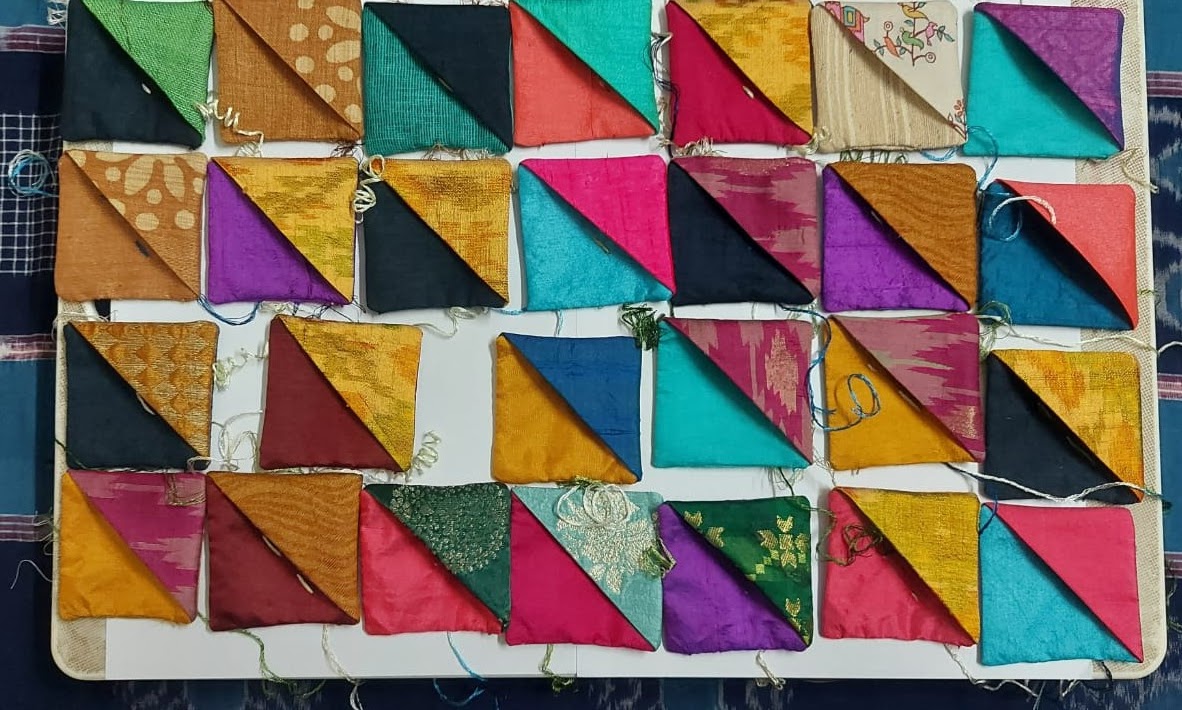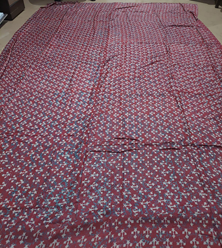This is not about quilt n quilting. But the inspiration for sure is from quilting.
To tie a self-made rakhee is happiness at another level. This year experimented a bit more in this domain. A few thoughts (= criteria) that i had in mind in this context
1. To make rakhee that could also be used beyond rakhee-poornima.
2. It being rakhee, the output had to be as something that could qualify to be rakhee in terms of size.
3. In rakhee the main importance is of the silk (though there are umpteen versions of rakhee made from plastic n whatnot, which I hate to the core)
4. Being a "sustainable quilter, the optimum usage of scrap fabric (in this case silk) is always a concern.
The idea of "book-marked" rakhee emerged from that. And then many colorful rakhees were made from the pure silk scrap collected from the local tailors. Basically book-marks were made (that are of the dimension roughly 2"*2". A silk thread was passed through it so as to be able to tie it as rakhee and also the thread could be removed later without spoiling the rakhee.
Many such rakhees were made. We are total 18 cousins - 11 brothers n 7 sisters. Plus this year decided to make these for my sister-in-laws and sisters too. It was a marathon to make that much quantity, but was fun. Enjoyed the process ... both of conceptualizing, designing and implementing.
Hope the recipients also find the products useful.
Thursday, August 11, 2022
Bookmarked Rakhees
Saturday, April 2, 2022
First Quilt in Pure n Raw Silk
First quilt made in Pure n Raw Silk
Have you ever experienced while gifting to someone dear that
you wish to give something very precious, something unique, some part of your
own? I have experienced this. Any “hand”-made project would serve the purpose,
but I found a priceless solution for this dilemma through quilting. There could
be so much value addition beyond what I could have expected! The present quilt
has a story addressing this thought (I just love this … every quilt has a story
that is unique to it).
Surabhi is the youngest pampered lad of our family and when
she was to leave Mumbai n go to Chandigarh for her post-HSC education, I wanted
to gift her something that will not only have utilitarian value, but also a
piece that she would treasure.
Story cut to quilting journey ….
I had the fascination of making a quilt in pure n raw silk.
(Thanks to Jaya Parker for sowing the seeds. Of course, Jaya is an accomplished
pure n raw silk quilting artist of another level). Had read her articles on how
to tame the naughty silk fabric into a well-behaved boy. So wanted to give this
a try.
I also was inspired by the concept of subtle quilting. I desired
to try that as well someday. Also I wanted a varying type of quilting into different
sections of the quilt. So was keen on quilting it myself (till date have not
found a solution for getting hand-quilting done in Mumbai Itself. I need to
depend on Nasik for that).
I get fascinated by modern quilt as much as I like traditional
quilts. I am still in the process of learning the various concepts under the
domain of modern quilts, but wanted to bring in at least some features of a modern
quilt. (I am aware that modern quilt police will NOT term this as a modern
quilt as it has a border).
Thus the process began with all these thoughts and this is
what was done ….
1.
Central portion of the quilt:
a.
The entire central portion is in pure and raw
silk. The printed part was the leftover fabric from one of my tops about 12
years ago. All the plain pieces were selected as per the broken down colours
from this printed fabric pieces. And all these pieces were from the trash
collected from the local tailors. The this was entirely in pure/ raw silk every
inch of it was fused with fusible interface to bring in ‘paper’-like
characteristics while piecing. Because of this paper-like nature it became
comparatively manageable to maintain the shapes and even easier to match the corners
while piecing.
b. Generally when one makes a specific design in a quilt while working with scrap, then there is a wastage of fabric to some extent. Since silk is a very expensive fabric(though I had got it for free), plus efforts to fuse the pieces were put in, the concern was not to waste the fabric. Thus, the design emerged from the dimensions in which the pieces were naturally occurring. Only one rule was followed … no adjoining pieces will be of the same colour (which I suppose has been achieved to 99% area).
2.
Border: The entire border is of pure
cotton from thrash of some lucknowee fabric. You may not believe this, but the black
portion of the entire border is made from a single thrashed piece. This is an
indicator of how much fabric is disposed off by the tailors. There were a few
gray coloured pieces of some khadee-like texture. (That had amazing texture to
make one fall in love with). So accentuated the border with those pieces.
3. Quilting:
a.
White thread: This was mainly used on black
n gray pieces that were in cotton. A few pieces of silk were also quilted with
white thread, but I was nto very happy with it (the little rough texture of
white thread n delicate nature of silk were not jellying well together).
b. Subtle quilting: This mode was used in most of the plain (silk) pieces. Tried to quilt in geometric shapes. As the threads for this category were chosen as perfectly matching with the fabrics, it helped in creating the ‘non-quilted’ look for those plain pieces. Not typical hand-quilting thread, but multiple strands of the normal sewing threads were used for this.
c. The printed pieces: These pieces had many colours and I did not want to spoil the look by a contrasting-coloured thread passing over the fabric part. Hence used black-colored thread for this quilting and ensured that the quilting is attempted only on black portion of the print.
d.
The game: Wanted to add a fun element to
the quilt. Hence this was added so that Surabhi may use this for playing game.
e.
Brownie: The colour chosen for this was mustard
as Brownie also has golden coat.
4.
Contributions by all the other family members:
a.
Aajee (Surabhi’s grand-mother and my
mother-in-law): Two of her cotton saries were put as batting (= the layer
of fabric that goes in between the top n the bottom layers of a quilt).
b.
Ajju (Surabhi’s grandfather and my father):
A sturdy part of his old shirt was used for creating label for the quilt
(unfortunately missed taking pic of that label)
c.
Nilima (Surabhi’s mom and my sister-in-law):
Her old discarded top’s fabric was used for creating that “S” on the quilt
(this attempt was also for the first time for me)
d.
Abhijit (Surabhi’s father and my brother):
The entire binding of the quilt is made from his scraped silk kurta due to
fading in some areas.
e.
Vivek (Surabhi’s uncle and my husband):
Vivek was instrumental in having the chakar game in quilted form on one of the
black pieces. He conceptualized it and helped me in designing it on the quilt
actually.
f.
Manasi (Surabhi’s cousin and my daughter):
When the brainstorming was going on what could be brought in from brownie,
(considering my limited or zero drawing skills) I had thought of a simple body
outline of Brownie, which will be quilted. When I was running short of time,
Manasi was requested to pinch in n draw that simple outline. She drew only
face, but tried to bring in her criterial attributes (that’s how she had perceived
Brownie).
g.
Brownie (everyone’s apply of the eye): Brownie
had done everything at every stage in this quilt right from sitting on the fabric
pieces when one is auditioning the fabrics n colours, rolling over the pieces laid
on the floor to inspiring us to have her in the quilt. The quilt would have
been indeed incomplete with her being there both in the process as well as in the
product.
h.
Myself: As mentioned earlier the printed
fabric was from the leftover of my dress material many years ago. Plus one of
my silk saries was used for backing. I got a lot of scolding for this as this
sari was in good condition and was already in use. But then Surabhi preferred this
over the other options.
Such a bad time management on my side for this quilt … when
Surabhi was to leave for airport at 3 pm, I was completing the quilt till 2:45
pm!
All in all it was a great learning experience. I could create
something unique through this quilt and also take my quilting journey to the
next level. I know that it is not the perfect product, but one quote is very
popular amongst quilters “Finishing is better than perfect” and I swear by
that. I have always loved speaking, discussing about quilts n the process (both
thought n method) of making quilts. That is why I have also loved writing about
the same. Thank u Surabhi for giving me the opportunity to do what I love to
do. It was so therapeutic!
Technical Details:
·
Material:
o
Main body: pure n raw silk
o
Border: cotton
·
Main technique used: Fusing
·
Dimensions: 60” by 90”
·
Date of completing: November 07, 2021
Ti Time taken: Roughly 3 months
Friday, January 21, 2022
The First Pieced (self-) Hand-quilted quilt
This is a delayed sharing.
I have been learning a lot
from the most amazing quilters with whom I keep interacting through social media. I have been taking
my baby-steps gathering inspiration from them. As a part of this journey this quilt
was made that had many firsts:
1. First
technically pieced quilt. The technical name of this design is ‘Rail Fence’ (Learnt
this name after completing the quilt.)
2.
First both-sided quilt
3.
First all hand-quilting by me for a huge one
4.
First 100% self-made by
me (Till then I had been outsourcing the hand-quilting)
5.
First quilt made using non-white
threads for hand-quilting
Since there were many firsts, there was
super-excitation and also lots of techniques and lessons learnt. There were many mistakes as
well. The biggest mistake was about the lighting during taking pics of the
quilt. Due to taking pics in the area shat was covered by a huge shade, the
beautiful yellow colour looks like dull and peach. The original yellow colour could
be seen only in the pic showing label. I love the concept of putting label to
self-made quilts. Quilters are bad in documentation. Label to a quilt is one
way of at least some documentation.
The quilt was made for someone to
whom I sent my wishes and hugs through this quilt.
I have a lot to learn in quilting.




















